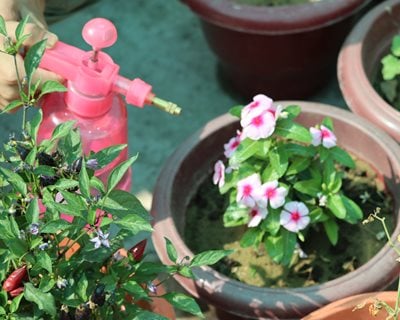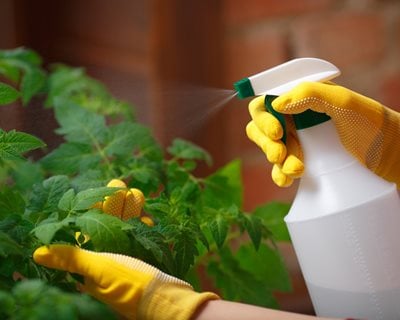Guide to Using Neem Oil
Learn how and when to use this natural pesticide on your indoor and outdoor plants Published 7/28/2022
Photo by: Harshit Srivastava S3 / Shutterstock.
One of the biggest challenges of gardening is to control pests and diseases that can damage or kill indoor and outdoor plants. Inorganic chemical treatments can introduce harmful toxins into the environment, cause harm to people and pets, and kill beneficial insects. Because of this, organic remedies have become the preferred method of pest and disease control in recent years.
Neem oil is a commonly used natural remedy for both indoor and outdoor plants. Learn more about this treatment, when and how to use it to help keep your plants healthy and thriving.
NEEM OIL FAQ'S
What is neem oil?
Neem oil is a natural pesticide made from oil that is pressed from the seeds of the neem tree (Azadirachta indica). Related to mahogany, this tropical tree is native to India and Africa. It is also used to control a wide range of insect pests and diseases. In addition to being a plant insecticide, neem oil is also used for a variety of medicinal and cosmetic applications.
What is neem oil used for?
Neem oil is an effective treatment for over 200 kinds of insect pests, and is most effective on soft-bodied chewing insects such as aphids, mealybugs, scale, spider mites, and whiteflies that feed on plant foliage. This remedy is also used to control Japanese beetles, lawn grubs, leaf hoppers, mites, nematodes, tent caterpillars, and thrips.
Sprays containing neem oil extract are also used to treat fungal and bacterial diseases such as anthracnose, black spot, blight, botrytis, fire blight, powdery mildew, rust, and scab.
How does neem oil work?
The primary active ingredient is azadirachtin. Neem oil works to repel and smother harmful insects, reduce their ability to feed, and disrupt the life cycle at all stages. Neem oil also contains other compounds that are effective in treating fungal and bacterial diseases.
Is neem oil safe for humans, dogs, and cats?
When used correctly, neem oil is safe for humans and pets. This natural pesticide is organic and breaks down quickly. Direct contact with the oil may cause mild skin or eye irritation. Avoid inhaling or ingesting neem oil and wash hands well after using. Minimize exposure and wear protective clothing for broader applications. Wash fruits or vegetables thoroughly that are sprayed with neem oil before consumption. Neem oil may be somewhat toxic to fish and other aquatic life, so caution should be taken around ponds or streams.
Is neem oil the same as horticultural oil?
Both are used as remedies to treat plants, but contain different ingredients. Horticultural oil is made from petroleum-based mineral oils or vegetable-based oils extracted from canola, cottonseed, or soybeans. Horticultural oils may be used to treat other problems or have different effectiveness.
Is neem oil safe for bees, ladybugs, and other beneficial insects?
When used correctly, neem oil insecticide is seldom harmful to earthworms or beneficial insects such as bees, butterflies, and ladybugs. These insects do not feed on plant foliage, so will not ingest the oil. Avoid spraying beneficial insects directly and apply early in the morning or late in the day when beneficial insects are less active. Learn more about beneficial insects.

Photo by: Lyashenko Egor / Shutterstock.
HOW TO USE NEEM OIL ON PLANTS
Neem oil products are available in different formulas, including dust, granules, wettable powder, cake, and concentrate. Solutions can be purchased in a ready-to-use spray bottle or you can mix your own from concentrate. Allow at least 4 to 7 days for it to work, and repeat applications as necessary according to instructions.
Here are the primary ways to use neem oil for plants:
Dormant spray: Apply when plants are dormant to kill overwintering garden pests and eggs. For best results, use neem oil on a dry, windless day. Wait until temperatures are at least 40 degrees F and delay spraying if a freeze is imminent.
Foliar spray: Use neem oil directly on leaves anytime during the planting season to control pests and diseases.
Soil drench: A soil drench is when neem oil is diluted with water and poured into the ground or potting soil. The solution is absorbed through the roots and distributed throughout the plant as a systemic that sucking insects will ingest. This method can be used outdoors, or on houseplants to eradicate fungus gnats, treat soil-borne fungal disease, and to kill insects, eggs, and larvae that are hiding in the soil.
NEEM OIL USE FOR SPECIFIC TYPES OF PLANTS
Houseplants: Indoor plants are susceptible to whitefly, spider mites, mealybugs, fungus gnats, aphids, thrips, scale, and fungal diseases. For infestations, spray foliage or drench soil every 7 days until pests are gone. As a preventative measure, drench the soil every 3 weeks.
When spraying foliage, make sure that the top and undersides of leaves are well coated. Test a small area of each plant first to make sure they are not sensitive to it. Avoid getting oil on furniture or fabrics to prevent stains or other damage.
Fruit trees: Neem oil can be used on fruit trees such as apple, cherry, nectarine, pear, peach, and plum. Use to control aphids, spider mites, caterpillars, coddling moth, meal worms, powdery mildew, scab, rust, and black spot.
The best time to apply neem oil is when trees are dormant to kill overwintering eggs and larvae. During the growing season, use neem oil as a repellant or to control infestations. Apply as a foliar spray or soil drench. Dilute neem oil concentrate with water and add a bit of liquid soap, which will help to mix the water and oil. Use a pump sprayer to cover a large area and reapply as needed. Spraying too frequently can damage or kill fruit trees.
Vegetables: Use neem oil for killing pests that are troublesome to vegetables such as aphids, beetles, cabbage worms, corn earworm, tomato hornworms, and whiteflies. It can also be used for fungal diseases such as leaf spot, mildew, rust, stem rot, and wilt.
Lawns: Neem oil is effective at treating lawn pests such as grubs and Japanese beetles, as well as fungal diseases including red thread, rust, or gray leaf spot. Circles of sunken, discolored, or dead grass can indicate pest or disease problems. Use neem oil mixture on affected areas as a foliar spray or soil drench.
Garden plants: Many ornamental plants will benefit from neem oil to treat pests and diseases. Evaluate and diagnose the problem and decide which method will be most effective.
NEEM OIL APPLICATION TIPS
- Neem oil may cause damage to sensitive plants, so test a small area and wait 24 hours for signs of leaf damage.
- Avoid using in harsh sunlight to prevent foliage burn. Apply early in the morning or late in the day.
- Make sure that foliage is thoroughly coated to effectively treat pests or diseases.
- Don’t use during extreme cold or hot temperatures.
- Refrain from using neem oil if plants are stressed due to over or underwatering, or after transplanting to avoid shock.
- Avoid spraying new seedlings, which can be sensitive to foliage burn.





